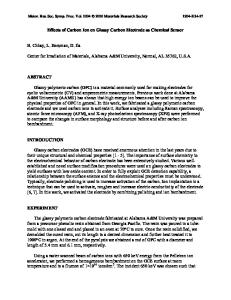Carbon Nanotube-Perovskite-Composites as New Electrode Material
- PDF / 1,056,257 Bytes
- 5 Pages / 612 x 792 pts (letter) Page_size
- 35 Downloads / 354 Views
V7.2.1
Carbon Nanotube-Perovskite-Composites as New Electrode Material Anke Weidenkaff1, Stefan G. Ebbinghaus1, Thomas Lippert2, Macarena J. Montenegro2, and Armin Reller1 1 Solid State Chemistry, University of Augsburg, D-86159 Augsburg, Germany, 2 Dept. General Energy Research, Paul Scherrer Institute, CH-5232 Villigen, Switzerland ABSTRACT In this paper we describe the synthesis and characterisation of La1-xAxCoO3 (A= Ca, Sr) (0 < x < 0,5) of different morphologies using pulsed laser deposition, ceramic methods and alternative soft-chemistry techniques. Furthermore the potential use of a La1-xCaxCoO3 /carbon nanotube composite material for oxygen electrodes is discussed. Keywords: perovskite, electrocatalysis, carbon nanotubes, La-cobaltates, nanocomposite
INTRODUCTION The stability and efficiency of oxygen electrodes of metal - air batteries and alkaline fuel cells will be decisive for their technical realization. The redox processes at the electrode in the highly alkaline media are responsible for the short lifetime of conventional teflon-bonded carbon diffusion electrodes. The oxygen evolution and oxygen reduction reactions in alkaline electrolytes occur via a two- electron pathway involving the formation of intermediate peroxide ions and OH- [1]. Perovskite type metal oxides (ABO3) with a lanthanide ion in the A position and a transition metal ion in the B position are known to be low cost, stable and active electrocatalysts for practical applications in fuel cells and metal-air batteries [2,3,4]. Particularly lanthanum cobaltates, manganates, ferrates and nickelates show good catalytic properties for the peroxide decomposition [5] [6]. For the production of gas diffusion electrodes, calcium and strontium substituted rare earth cobaltate powders with perovskite structure are synthesised. To study the influence of the particles size and shape co-precipitation-, ceramic-, complexation- and microemulsion processes are applied. As perovskites are not highly conductive, high surface area carbon and teflon as binder has to be added for a functional composite electrode material. We prepared a carbon nanotube composite material by a catalytic hydrocarbon dissociation reaction on metal oxide particles. With the combination of the properties of the metal containing part and the carbon nanotubes in a carbon nanotube/metal oxide-composite the carbon/metal oxide interface as well as the chemical and thermal stability of the electrode material can be improved (as carbon nanotubes are known to be more stable than carbon black). Since carbon itself is catalytically active for the oxygen reduction and evolution reaction as well, it is necessary to prepare additionally electrodes on inactive substrates and with well defined electrolyte/catalyst interfaces to study and compare the oxygen reduction/evolution reactions for different perovskites. In our experiments a modified pulsed laser deposition (PLD) technique with reactive gas pulses [7] is applied to grow dense crystalline La- cobaltate films on various substrates. EXPERI
Data Loading...











